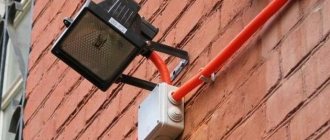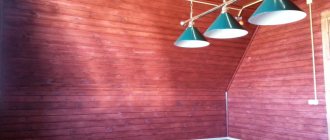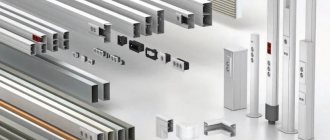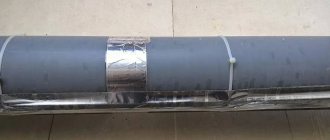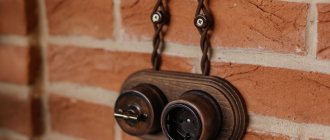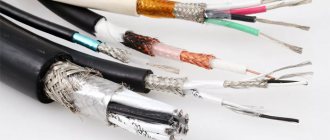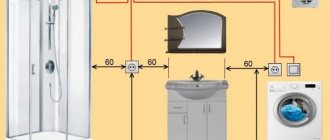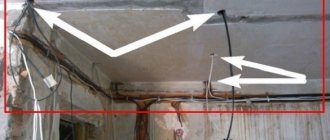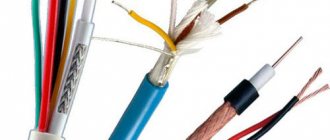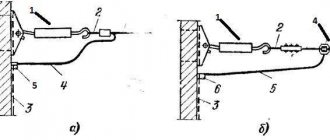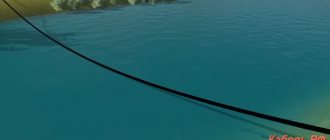Electrical communications in an apartment are one of the most important conditions for comfortable living in it. But at the same time, I want all the wires that supply energy to electrical appliances not to be lying around everywhere, but to be securely hidden behind the walls, in niches, so that they are not conspicuous. An excellent option for laying wiring is an electrical baseboard, which will make all the wires invisible to the eye. How to choose the right baseboard with cable duct? Are there any special features in installation? Read about this in detail further in our article.
Electrical skirting board
Electrical plinth - a solution to the problem of laying cables in an apartment
The problem of masking wires remains relevant not only for new buildings, but also for old houses. During a major overhaul of a secondary home, there is often a need to replace outdated, worn-out wiring that cannot withstand the load, because every year more and more different technical devices appear in the apartment.
Wires in the room must be hidden
Often indoors, wires are placed along the walls, which looks extremely unesthetic. In addition, such wires can become a source of danger, because they are easily damaged. And children and pets do not realize the dangers posed by wiring, which is why they can become victims of accidents. Fortunately, there are now several basic methods that allow you to insulate wires, keep them out of sight and protect others from contact with them.
Table. Methods for masking electrical wires.
| Method | Advantages and disadvantages |
| Laying inside walls | This is the most difficult, but also the most reliable way to disguise wires. It is usually carried out during the construction of a building or major renovation of a building. In order to hide the wires inside the walls, it is necessary to make special channels, and this is a labor-intensive, noisy task that creates a lot of debris. After laying the wires in the channels, they (the channels) are concreted. The main disadvantage of this method is the lack of access to the wires and the impossibility of replacing them if damaged. To eliminate the faults, the walls will have to be hammered again, and this will entail the need for cosmetic repairs. |
| Corrugated pipes | Corrugated pipes are plastic ribbed casings inside which wires are placed. The tubes themselves are usually laid along the walls, less often - in the floors. But they look unpresentable, although they allow you to easily restore a damaged section of the power system quite quickly and without much expense. Corrugations have an affordable price and are often used on industrial sites and in utility buildings. |
| Cable channels | Neat plastic casings are easily attached to the corners of walls, along floors, even directly on the wall, and wires are laid inside them. These are, of course, visible details that do not always decorate the interior, but in any case they look much better than corrugated tubes. Likewise, they provide easy access to wires if necessary. |
| Skirting boards with cable channels | Perhaps the best option for laying wires along walls. At least the cables will no longer be lying around the perimeter of the room, but will be securely hidden in small cavities, which are provided in such skirting boards and are covered with a decorative strip. Affordable, beautiful skirting boards are not in vain considered one of the best options for laying electrical wiring. |
cable channel pvc
Features of the plinth
They are mostly made from synthetic materials. This makes it both simpler and cheaper. As a rule, the price of wooden plinths is much more expensive. But in the case of PVC, everything is much simpler, and even a non-professional can install such a product.
The channel itself is covered with a special panel that hides both the wires and the fastening means (screws or nails). It also helps to beautifully join the plinth itself in a straight section. There are sealing rubber bands at the top and bottom that hide uneven floors.
What are skirting boards with cable channels?
A plinth with a cable channel or an electrical plinth is a special type of finishing floor plank, which is designed not only to hide deformation gaps when installing the floor, but also to disguise wires for various purposes.
On a note! Even cables such as Internet cable, optical fiber, local network wires, telephone and much more can be laid in the cable channels inside the baseboard.
Skirting board with cable channel
Within the apartment, an electrical plinth will allow you to lay wires without much effort so that they are invisible to the eye. At the same time, the decorative element also provides a high level of security, because access to the cables will be limited.
Advantages of a plinth with a cable channel
Advantages and disadvantages of sockets
The advantages of the devices are as follows:
- the ability to install an electrical outlet absolutely anywhere in the apartment;
- discreet, excellent fit into the design of the room;
- large selection of colors and styles;
- Convenience of switching on equipment;
- Minimum wiring expenses;
- High security;
- No risk of accidental damage to cables.
Among the disadvantages, experts include the danger of a short circuit due to careless handling or water ingress - this may well happen while washing the floor.
Design features of floor skirting boards with elements for electrical wiring
Skirting boards with cable channels, depending on the purpose and manufacturer, can be of different types, shapes and sizes, but at the same time they have a similar structure. The main element is a mounting strip, thanks to which the decorative element is firmly fixed to the wall.
Fastening the baseboard with cable duct
On a note! The plinth along the wall can be secured in different ways, including using self-tapping screws, dowels, and adhesives.
The mounting plate on the outside has a special shelf or groove into which the wires that need to be hidden are placed. For some types of products, the groove may be located behind the baseboard itself. Cable cavities can have different parameters, which often depend on the manufacturer and size of the decorative element. This determines the number of wires that can be laid inside the baseboard.
Plastic plinth with cable channel
Fixation of the wires inside the baseboard is ensured by a thin decorative strip, which, after laying the wiring, snaps over them. The element does not require additional fasteners. Interestingly, the bar can also have different dimensions.
Features of installing a plinth with a cable channel
Also, skirting boards can be either single-channel or have several channels at once. In a single-channel, depending on its dimensions, up to 5 wires can be laid at once. Multi-channel skirting boards have a compartment with a decorative strip, as well as a place for cables behind the skirting board itself.
Important! There is another type of electrical skirting board. This decorative element is solid, but with a recess for wires in the back. In this case, the cables will be fastened along the wall using special clips, and then carefully covered with a plinth, which snaps onto these clips.
The plinth is attached using clips
But for proper installation of electrical skirting boards, you may also need other elements - special components:
- external and internal corners for connecting individual plinth strips in the corners of the room;
- connectors for plinth strips , necessary when installing two pieces of plinth along a long wall;
- stubs;
- mounting boxes for wiring.
Electrical skirting boards, like regular ones, can be easily matched to the color scheme of the interior and its style. They can be made to match the color of wood, stone, white, gray or any other color. Certain categories of products can be easily painted with special acrylic paint.
Socket box on the baseboard
How to lay electrical skirting boards
Before starting work, you should calculate the required length of wires. It is better to purchase them with a margin of 10-20%. Then the type and length of the baseboard itself is selected. In this case, it is worth paying attention to how many and what cross-sectional conductors will be laid in it. At the same time, it is important to take into account color and design.
Preparation of the workplace
Before installing a new electrical skirting board, it is necessary to disassemble the old one. Crude tools such as a pry bar or a heavy-duty screwdriver are suitable for this. The workplace is cleared of debris, dust and dirt. If necessary, the defects in the corner between the floor and the wall are covered with putty.
Next, the new channel is applied to the installation site. It is more convenient to do this together. Mark the mounting holes on the wall with an awl or pencil. They must be done with a hammer drill in impact mode.
Removing the old baseboard
Installation of cable channel
A plinth with a channel for wiring can be easily installed even by a person without experience. There are several important points to consider:
- To determine the required length, you need to calculate the perimeter of the room. You need to subtract the width of the doorway from the obtained value, because the corner tray will not be laid in it.
- It is better to fasten the dowel using nails or self-tapping screws, since the glue is too demanding on the materials it holds together.
- Corners and various adapters. If you forget to install at least one, the structure will have to be disassembled and reinstalled.
Installing the Removable Cover
The cover is installed with latches. This method is convenient and does not require third-party tools. The successful closing of the lid can be judged by a characteristic click. It is important to ensure that there are no gaps left. Therefore, after snapping the cover into place, its correct position is checked visually or by touch.
Plastic skirting board with snap-on lid
Skirting board with separate front part
This type includes products made from MDF. The fastening strip is installed strictly parallel to the floor. It is better to monitor the accuracy of measurements using a level. Or you can resort to a life hack. Cut two small fragments from the front part and use them as templates (samples, standards) when installing the mounting strip.
How to start and remove wiring
To remove the cable from the baseboard, you can use one of three methods:
- Carefully cut the groove in the required location. The method requires skill and is dangerous to perform, because the knife blade can easily slip off your fingers.
- Drill a hole. It will turn out neatly. But it can only be done if you have a thin drill of the required diameter at hand.
- In the place where the wire is removed, slightly heat the plastic with a lighter and carefully press the groove under the wire. This method should be used only with knowledge of the matter and some experience. However, the end result is the most aesthetically pleasing.
Cable pulling in the baseboard
Installation of sockets
Expensive manufacturers often produce sockets that are sized specifically for their electrical baseboards. In this case, installation is the simplest. There is no need to cut anything or adjust it to fit. Universal sockets are also available for sale. For them, you will have to cut off part of the baseboard and carry out more complex work. In terms of money, the second option will be cheaper.
Box for socket on baseboard
Materials
The plinth can be made of several materials. However, not all of them meet certain requirements and some may not be suitable for wiring.
Table. Types of skirting boards depending on the material.
| Material | Description |
| PVC or polyvinyl chloride | The most commonly used type of skirting boards, as it has many advantages. This material meets all fire safety requirements. PVC skirting boards are inexpensive, but at the same time they are durable, elastic and strong, and are not afraid of exposure to moisture and a number of chemicals. However, under strong mechanical stress, PVC skirting boards can easily break. There are also special skirting boards for laying high-voltage cables - they are made of a special type of PVC, which has maximum fire safety. |
| Tree | It is undesirable to use skirting boards made from this material as electrical equipment, since their fire hazard is quite high. However, wooden skirting boards are highly environmentally friendly. |
| MDF or fibreboard | Such skirting boards are usually solid and require fastening of cables using clips. According to manufacturers, MDF is a non-flammable material, but it still does not have the same fire safety ratings as PVC skirting boards. That is why it is recommended to use it only for laying communication wires. |
Veneered plinth
Expert opinion
Afanasyev E.V.
Chief editor of the pol-exp.com project Engineer.
It is best to use PVC skirting boards for laying wires in an apartment or private house. They have a presentable appearance and are not prone to fire even if the wires are shorted.
Plastic floor plinth with cable duct
Methods for installing skirting boards
The ceiling plinth is attached in two ways:
- Foam or polystyrene ceiling molding can be installed after gluing the walls with tiles or wallpaper, gluing them with a special sealant or using “Dragon” or “Moment Installation” adhesives.
Installation of ceiling plinth
- The walls and ceiling are carefully leveled and then primed. The fillets are attached to them using putty or sealant. After this, wallpaper is pasted or another decorative coating is applied. This option is preferable.
Cutting fillets
Cutting process
To complete the work you will need to purchase:
- Miter box.
- A sharp knife or hacksaw for metal.
- Small spatula.
- Bucket for mixing putty.
- Adhesive mixture.
Cutting skirting boards in a device
You can buy a miter box in a store, or you can build it yourself, so that the product helps you make cuts precisely at angles of 45° and 90°.
Cutting skirting boards
The plinth in the tool is positioned at an angle, as it will be glued to the wall.
Tip: Fillets with cable ducts should be cut with a hacksaw, without force, so that chips do not appear at the cut points.
Cutting wide baseboards without a miter box is unthinkable
To better imagine the process, you should watch the video first.
Electrical wiring in baseboards - pros and cons
Of course, laying wires inside baseboards has its advantages and disadvantages; So, the advantages include:
- the ability to lay electrical wires without destroying walls or damaging their finish;
- the ability to hide communication cables (Internet and telephone, as well as TV antenna) from prying eyes;
- if necessary, it is easy to open the plinth and gain access to the wires for their replacement or repair;
- a large selection of colors and shapes, which allows you to choose exactly the type of plinth that will look perfect in a particular interior;
- you can choose a plinth with one or more cable channels;
- ease of installation - no special skills required;
- ease of care.
Fastening the baseboard with cable duct
The disadvantages of skirting boards with cable ducts are usually associated with some features of specific models:
- skirting boards with flexible edges lose their elasticity over time, which is why gaps may appear between the floor covering and the decorative element itself;
- opening certain types of plinth is quite difficult without the risk of damaging the fasteners;
- Skirting boards made from cheap PVC are prone to fading, are very fragile, and can crack during installation.
Such skirting boards have their disadvantages
Types of skirting boards
Backlit
Manufacturers do not stand still and offer various options for their products. One of them is transparent. Made from PVC, MDF. This type of skirting board is used for lighting in rooms where lighting is not a priority - for example, in corridors. LEDs are inserted into the fittings, which create a certain lighting, and at the same time are a design solution. The price is quite reasonable.
Ceiling
Sometimes the floor surface does not allow anything else to be attached to it. In this case, use the ceiling type of plinth. Another – and more correct – name is fillet. It also comes from various materials, for example, MDF (laminated). Plastic panels are most often used. The best option is made of foamed PVC. With high quality, these plinth cable channels have a reasonable price and are not afraid of ultraviolet radiation.
They are placed in the same way as those discussed above. The only difference is convenience: it is more comfortable to work on the floor than under the ceiling, which means that the dimensions must be maintained more accurately. And one more tip: it is advisable to attach the fillets before wallpapering the room. The joints will be very difficult to eliminate. Using putty or sealant, it is very easy to damage the wallpaper irrevocably.
Manufacturers offer a large selection of different skirting boards: laminate, PVC, natural materials. Price and quality also vary greatly. Thus, anyone can choose whatever they want: the modern market fully satisfies the demand in this segment.
Preliminary measures before installation
Before you begin installing electrical wiring inside the baseboards, you will have to carry out a number of preparatory measures. They should not be neglected, because through them it will be possible to ensure the fastest and most correct installation, while also taking into account decorative aspects.
- First you need to decide on the color and size of the skirting boards. It will help you with this our article. Here everything will depend on the wishes of the apartment owner, as well as on the interior of the rooms and their dimensions. So, in a room with high ceilings you should not install narrow baseboards. In dark rooms, radically light or dark finishing strips are not used unless they are combined with other interior elements.
Light floor plinth in the interior
- Even before you begin installing the baseboards and laying the wires, you should decide where the various electrical devices will be located. This will allow you to choose the correct location of sockets and lay the cables as secretly as possible. It is best to immediately draw up a diagram of where and how the wires will be laid.
- It is important to calculate the amount of plinth - it will depend on the perimeter of the room. Do not forget to take into account the amount of possible waste that is generated during cutting of the material. This is about 5-10%.
- At the design stage, the size of the cable channel is also calculated. Here the choice will depend on how many wires will be laid in it.
The procedure for performing work when installing skirting boards
Attention! You should not lay many cables inside one cable channel. In this case, it is not recommended to lay electrical wires inside the same channel together with communication wires.
At the preparatory stage, it is important not to forget to calculate and purchase components in the required quantity. They will not only facilitate the installation process, but will also make the entire structure beautiful and neat. In this case, the components must match the color and size of the baseboard itself.
Accessories for plastic skirting boards
Types of skirting boards for cables
There are two types of wire trays:
- The product has a recess on the front side. The cable fits into it. After which the groove is closed with a compact lid. It can be quickly removed and returned. A good option in case new wiring is added in the future, but you don’t want to remove the entire baseboard.
- Initially, only the tray is attached to the wall. A wire is attached to it. A massive front cover is placed on the structure. The assembly turns out to be more durable and capital. Suitable for families with small children, because getting to the cables is not so easy.
Arbiton skirting board design with front cover
Sequence of installation work
To install a plinth with a cable channel and lay electrical wiring in it, you will need various tools. This is a hammer drill, a hammer, a screwdriver or screwdriver, a tape measure, a level, a pencil, and a tool for cutting plinths.
Step 1. First you need to cut the baseboards into pieces of the required length. For example, the length of one section of the wall is measured using a tape measure, and then the same length is laid on the baseboard strip.
The length of the wall section is measured
Dimensions are transferred to the baseboard
Step 2. The plinth is cut into the required lengths.
How to cut a plastic skirting board correctly so that it can be neatly joined in the corners? Read in the special article.
The plinth is cut
Step 3. The decorative strip is removed from the plinth sections.
The decorative strip is removed
Decorative strip removed
Step 4. The plinth is placed in its place against the wall, holes are drilled in it inside the groove for the wires.
Drilling holes in the baseboard
Advice! It is best to start installing the plinth from the inner corner.
Step 5. Decorative inner corners are placed on the edges of the plinth strips. Holes are drilled with their (corners) taken into account.
A decorative inner corner is put on
Hole drilling process
The holes are ready, the elements are connected with an internal corner
Step 6. While forming the holes on the baseboard, marks remained on the wall for drilling for dowels. Holes in the walls are made using a hammer drill.
Holes are drilled in the wall
Step 7. Plastic dowels are inserted into the prepared holes in the wall.
A plastic dowel is inserted
Step 8. The plinth is installed in its place and screwed to the wall with self-tapping screws.
The plinth is screwed to the wall
Another photo of the process
Step 9. The cable is laid in the channel.
The cable is laid in the channel
Step 10. Then the cable channel is closed with a decorative strip.
The channel is closed with a decorative strip
Step 11. The cable in the outer corner area is pulled through the outer corners. The corner is installed in its designated place.
Outer corner
Installation of the corner
Step 12. Install the remaining decorative strips.
Laying decorative strips
Another photo of the process
Step 13. Install plugs for the edges of the baseboard.
Installation of plugs
Step 14. If necessary, install a socket box. To do this, holes for dowels are made in the wall where it should be. Then the dowels are inserted and this element is screwed onto the screws.
Holes for dowels are drilled
Photo of the installation process
Installation of a socket box
Video - Installation of plinth with cable duct
Electrical wiring inside the baseboard is a different idea even if the main wiring inside the walls has failed. In this case, there is no need to groove them and change the wires; it is much easier to use these decorative elements. An electrical baseboard will reduce labor costs and even save your wallet from unreasonable expenses for repairs, which will not be needed at all if you decide to lay wiring inside the baseboards.
Dismantling the baseboard must be done in order to be able to properly lay the new floor covering, as well as in order to replace old products. The procedure is quite simple, and therefore you can do it yourself. Instructions can be found in our special article.
Preparation for installation
After choosing the type and model of the ceiling plinth, a number of preparatory works are performed:
- A diagram of the laying and distribution of wires around the room is drawn up to connect electrical devices: lighting devices, TV, music center, video cameras, fire or burglar alarms, etc.
- A calculation of the required materials is made: the perimeter of the room and the length of the bends are measured. Everything is summed up and the resulting figure increases by 5-10% (including waste during fitting).
- The number of internal and external corners, connecting elements, corner brackets, bends, plugs (separately left and right), boxes, sockets, switches and other fittings that will be needed for installation of baseboards and wiring is determined.
- The amount of fastening materials is calculated: self-tapping screws and dowels 6x40 mm (every 40-50 cm plus 20% for uneven surfaces), glue, plinth strips, electrical clips, if wires are to be fastened to the wall or ceiling.
- Tools are being prepared:
- roulette;
- pencil;
- ruler;
- level;
- miter box;
- perforator;
- screwdriver or screwdriver;
- hammer;
- hacksaw;
- sharp knife.

